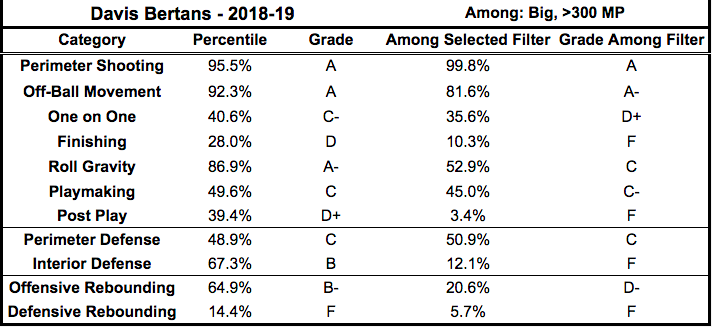
Davis Bertans is becoming an elite role player
The San Antonio Spurs are rolling. Since December 7, they have an 8-2 record and an 18.1 net rating that towers over every other NBA team by nearly nine points per 100 possessions.
There’s a lot of credit to go around. San Antonio’s improved team defense has made huge strides. But there are also several individuals who have set themselves apart with strong play.
Davis Bertans is one of those individuals. The 6’10” sharpshooter has been dialed in from long distance and has had a generally great campaign.
Let’s break down the Latvian Laser’s season and some of the context behind it.
Bertans’ journey to NBA relevance
Bertans’ basketball career is a lesson in patience and persistence.
The 6’10” forward started playing pro ball at a very young age. He joined Latvia’s ASK Kadeti II in 2007 and played for a variety of teams in Latvia, Slovenia, Serbia and Spain over the next nine years.
The Indiana Pacers drafted Bertans 42nd overall in 2011, midway through his run in Europe. The Spurs (who else?) decided to take a flyer on the 18-year-old prospect and acquired him as a throw-in to the Kawhi Leonard-George Hill deal.
Bertans tore his right ACL twice in the next four years. On top of that, he was already missing half of the ring finger on his shooting hand from a wood-cutting accident during his childhood.
But he recovered and finally showed the Spurs’ brass that he deserved to come stateside in 2016.
Bertans had to work hard to gain Gregg Popovich’s respect. His role was inconsistent in both the 2016-17 and 2017-18 seasons. He would usually play significant minutes in garbage time or when regulars were injured or resting, but he couldn’t grab a regular rotation role when the team was mostly whole. His play was respectable overall, but he was inconsistent, like his playing time.
San Antonio didn’t give up on Bertans. The Spurs inked him to a two-year, $14.5 million deal that many people deemed an overpay.
This year has been a coming-out party for Bertans now that he’s solidified his role as a key rotational reserve. He’s proven to be an absolutely elite shooter and an impactful all-around player.
Bertans’ stellar shooting season
The consistency of Bertans’ role this season has helped him find a shooting rhythm.
You might see an average of 7.7 points in 18 minutes per game and assume that Bertans has been an average bench player on the offensive end.
Not even close.
The third-year forward leads the NBA’s qualified marksmen in three-point percentage (50) by a healthy margin despite coming into the season with a career 38.4 percent success rate. He’s torching the nets with a 29-of-46 (63 percent) December.
His true-shooting percentage is also an otherworldly 71.2 this season. Literally no one in NBA history has accomplished that number in a season with as many field-goal attempts as Bertans has taken. Again, this number is on the rise. The Latvian Laser’s true-shooting percentage is 83.9 in 11 December games.
Opposing teams are covering Bertans tighter than they have in the past. That’s certainly a factor in his career-low usage percentage (13.7).
But Bertans has adjusted by taking and making more difficult threes. He’s made plenty of shots against tight contests, off the dribble, on the move and a few feet behind the arc.
powered by Advanced iFrame free. Get the Pro version on CodeCanyon.
Notice how he still always keeps his feet square and his upper-body technique consistent.
Bertans’ overall impact is clearly positive
Bertans is killing it in impact stats this year. He ranks No. 37 in the NBA in PIPM (plus-2.1), 22nd in POE (plus-2.2) and 32nd in Real Plus-Minus (plus-2.87).
This is the full list of players who rank at least as high as Bertans in all three of those stats: LeBron James, Giannis Antetokounmpo, Kawhi Leonard, Paul George, Kyrie Irving, Damian Lillard, Mike Conley and Pascal Siakam.
Bertans’ best skills are shooting and spacing the floor with smart off-ball movement, as his BBall Index talent data shows.

On offense, Bertans is not comfortable doing a lot of things with the ball in his hands. His unimpressive talent grades in one on one, finishing, playmaking and post play demonstrate that.
But that’s fine. DeMar DeRozan, LaMarcus Aldridge, Rudy Gay and Derrick White do plenty of that already. Any good team needs a balance of of capable on- and off-ball players. Bertans helps the Spurs offense by being the latter, and only facilitating only every once in a while. He hardly turns the ball over, with just 15 miscues in 559 minutes this season.
On defense, Bertans is agile for his 6’10” frame, so he’s decent on the perimeter. He contests more three-pointers per 36 minutes (5) than any rotation player not named Derrick White. He’s best when he can cover offensive players that are somewhat similar to his skill set.
The most potentially dangerous weaknesses for Bertans and his thin frame are defensive rebounding and poor rim protection. But he always plays with either LaMarcus Aldridge or Jakob Poeltl, both of whom do those things well. Rudy Gay, Dante Cunningham and DeMar DeRozan also chip in to help with those areas. Bertans does an excellent job switching with teammates to keep him away from precarious matchups near the basket.
The Spurs’ defensive and offensive rebound percentages both decrease with Bertans on the court compared to when he’s off, but the dips are negligible (25.5 to 25.3 and 75.7 to 75, respectively).
In terms of rim protection, the Spurs’ opponent free-throw rate actually gets much lower with Bertans on the court (0.230 to 0.202). San Antonio opponents also score slightly less in the paint per 100 possessions when Bertans is playing (45.9 to 45.2 points).
Final thoughts
Bertans is easily worth $7.25 million per year when he’s making this kind of impact for the Spurs.
His tremendous work shooting threes and moving off the ball is among the best in the entire NBA, and it’s been a godsend for a Spurs attack that revolves around two non-spacers. Bertans has weaknesses, but he has the smarts and San Antonio has the personnel and scheme to cover for them.
Pop has given Bertans at least 23 minutes in four of the last five games. The pattern needs to continue if the Spurs plan to continue their charge up the Western Conference standings.
Note: All statistics are from Basketball-Reference.com or NBA.com. All video clips are from 3ball.io.
Graphic by Aidan Lising
